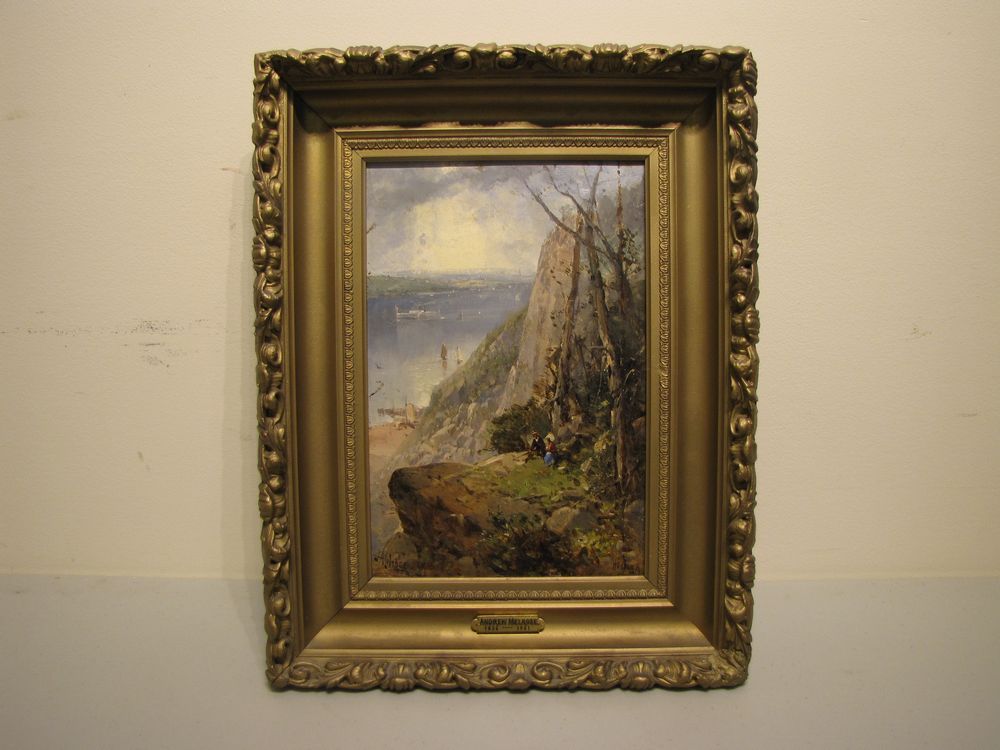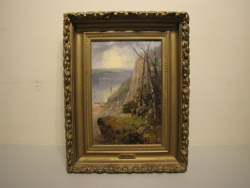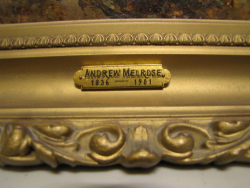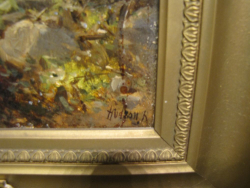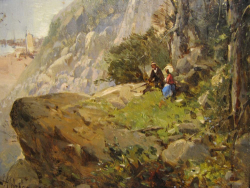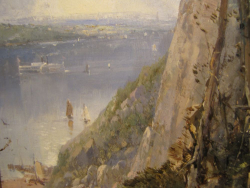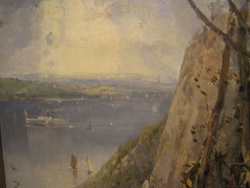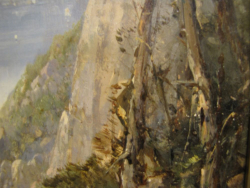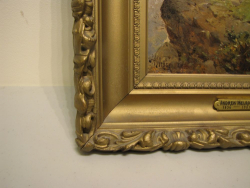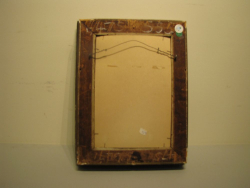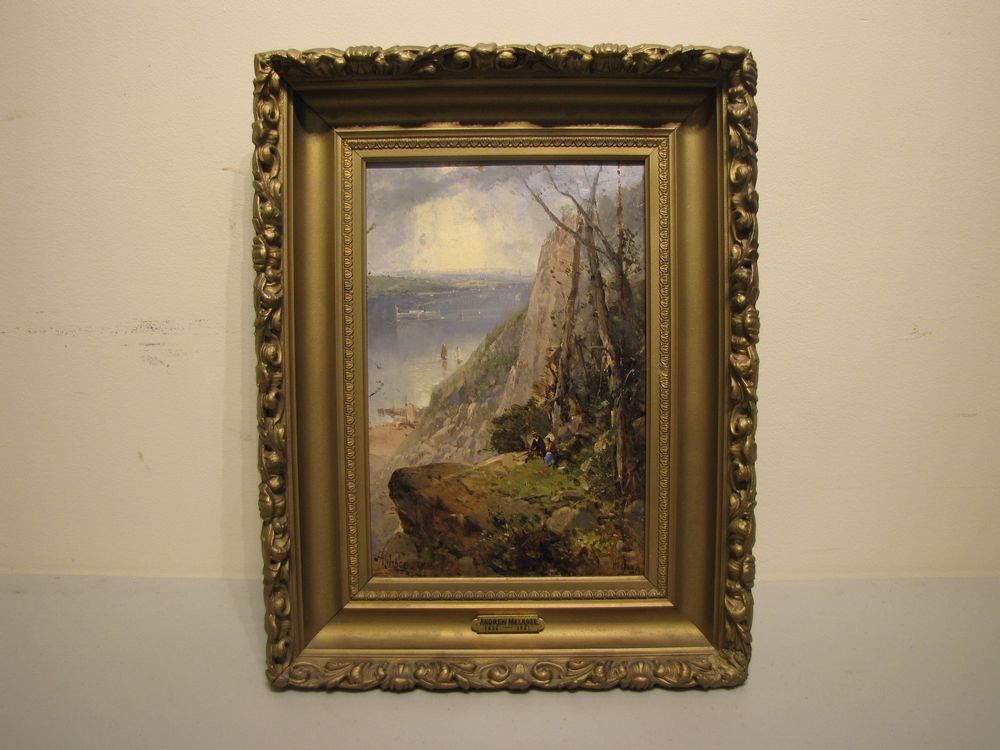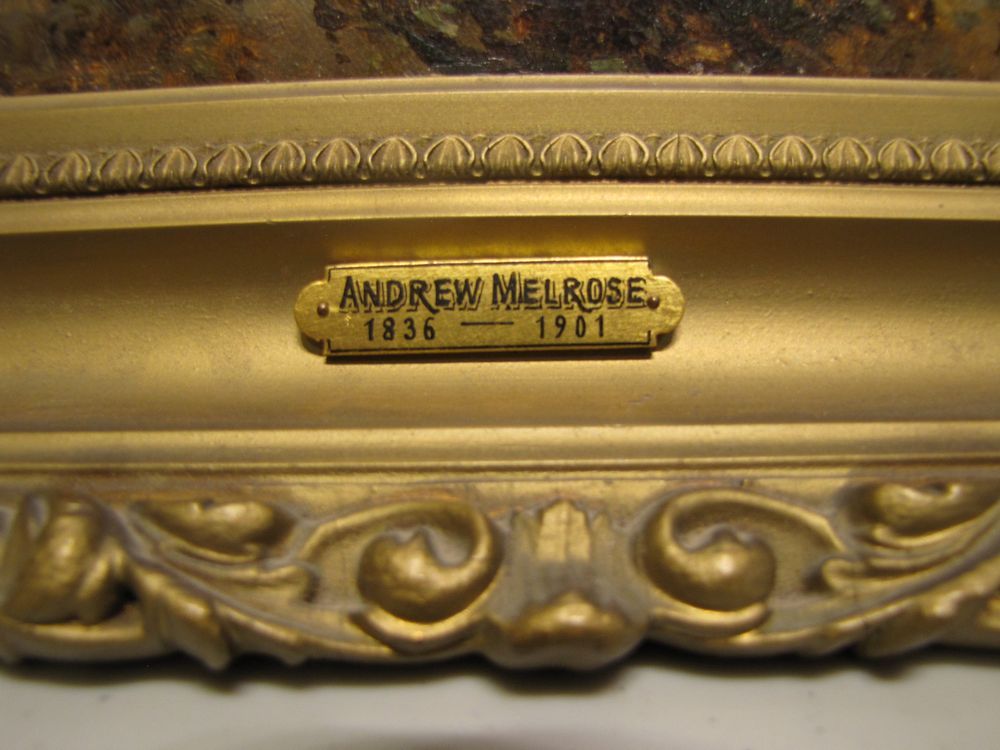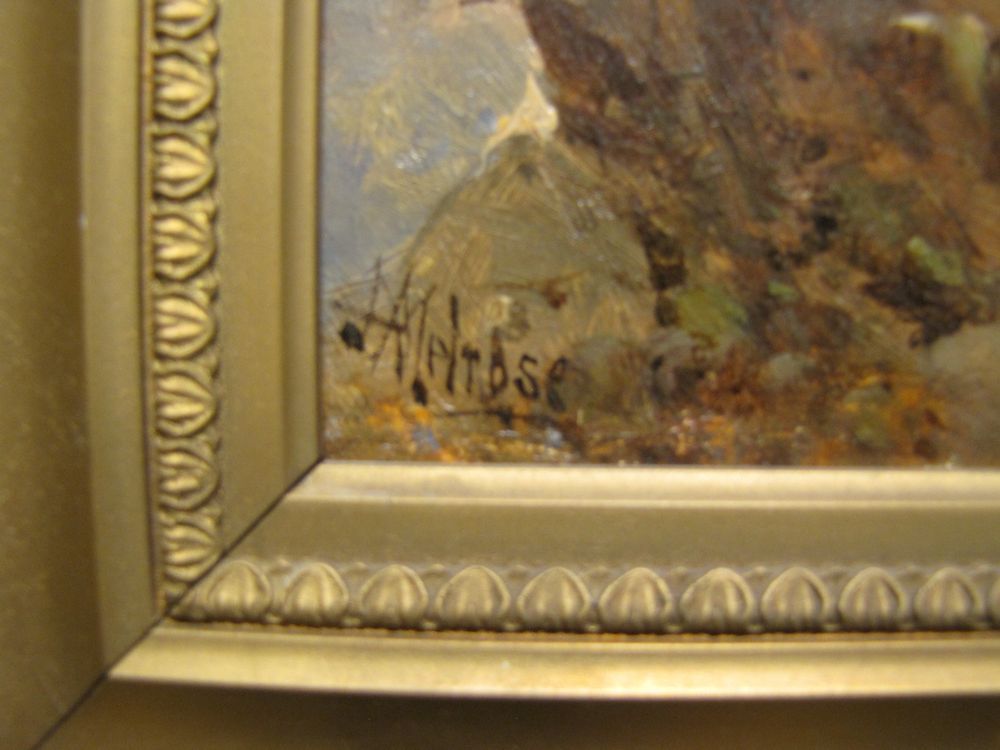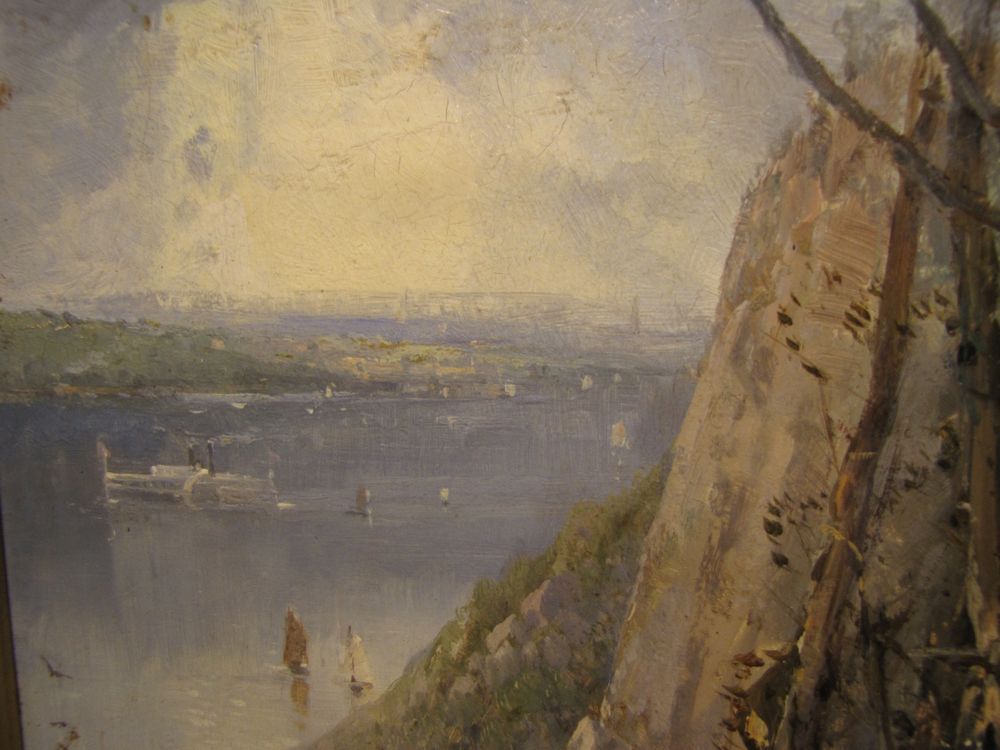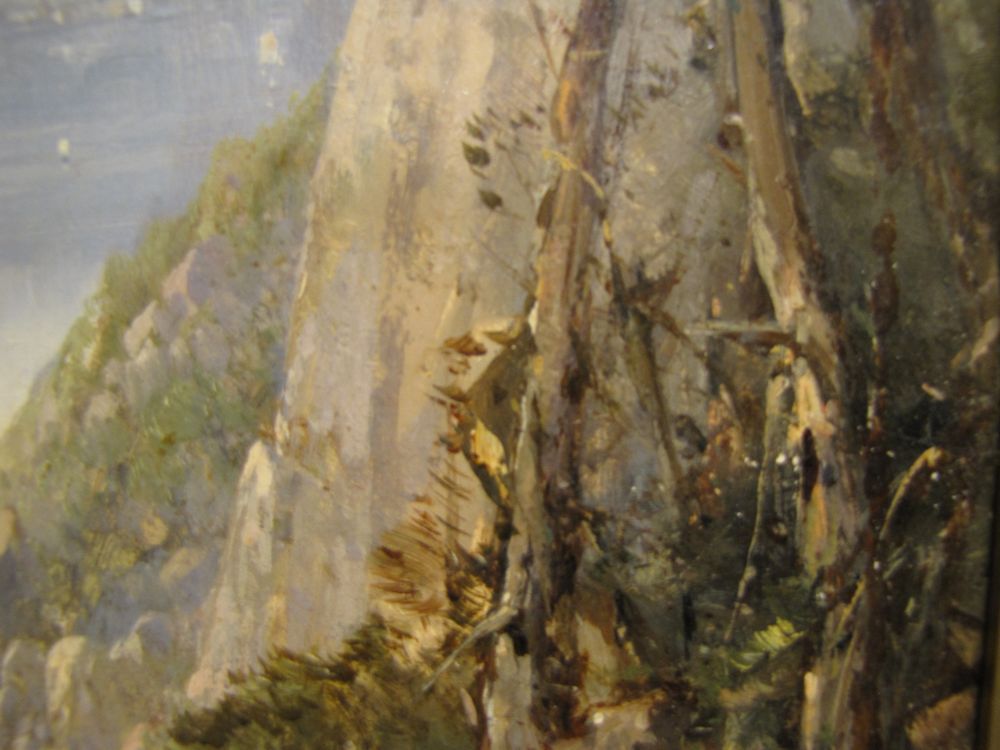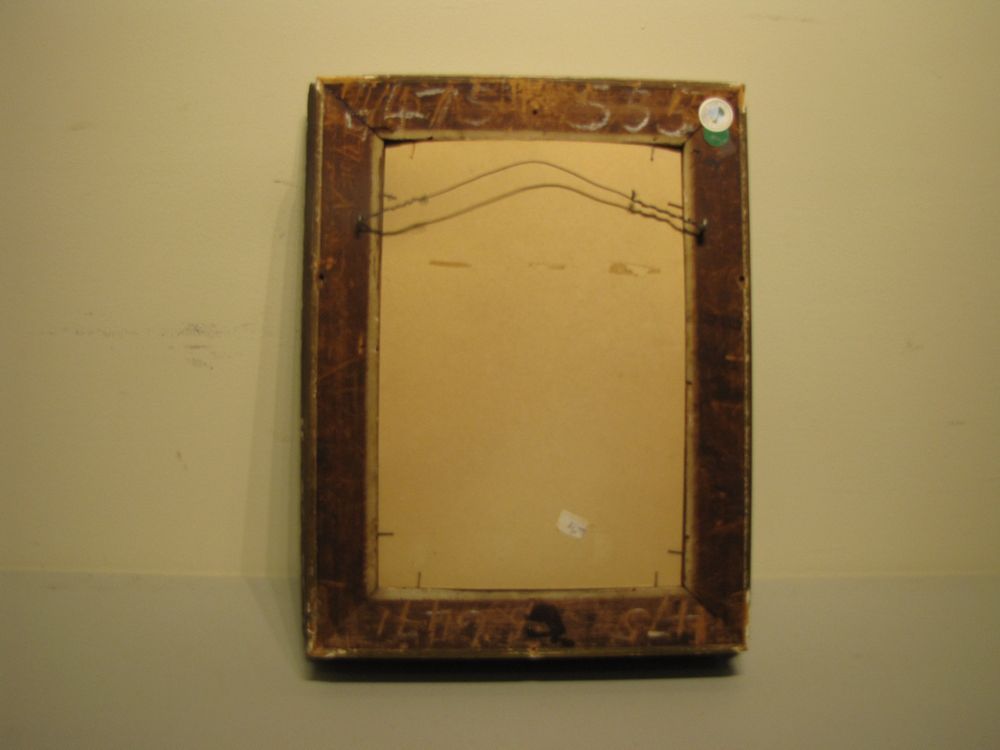This curated auction of Hudson River Paintings for sale is from the personal collection of Robert & Susan Doyle of Fishkill, NY. The Doyle’s are offering sixty-two American 19thC Hudson River School paintings at auction. All
Hudson River paintings in this sale are original works and almost all have been professionally cleaned and conserved. The first American School of Art is known as “The Hudson River School,” consisting of mid nineteenth century “Nature Painters” who found spirituality in nature. These adventuresome
Hudson River artists hiked to see impressive views. They sketched and did studies in the field to bring back to their studios to create finished paintings. The Hudson River served as the main route of travel to the best places, as well as provided the best subject matter. New York City, with the National Academy of Design to exhibit at, was the center of the American Arts world in the 19thC. These “Nature Painters” celebrated and depicted the pristine magnificence of the American landscape of the 19th Century on their canvases. Now you can experience the beauty, tranquility and grandness of Nature from the first American School of Art; the Hudson River School. Register and Bid now!
Items are located in Fishkill, NY.
Payment is due by Friday, February 18 at 3PM. All lots are subject to seller approval.
Pickup is by appointment only and must be completed by Monday, February 28 at 3pm.
All lots sold as is, where is. There is a 15% Buyers Premium for all lots purchased. Payment methods for non-vehicle & non-equipment is cash (by appointment only), Visa, Master Card, or Discover card.
Preview available online 24 hours or by appointment to "Registered Bidders" only from Wednesday February 2 to Wednesday February 16 in Fishkill, NY . To schedule, email our office at info@AARauctions.com.
*NOTE* Shipping may be arranged with proper identification through a third party shipper.
Address will be given to winning bidders after the auction.
Click More Info/Bid Now for additional photos.
�
Payment is due by Friday, February 18 at 3PM. All lots are subject to seller approval.
Pickup is by appointment only and must be completed by Monday, February 28 at 3pm.
All lots sold as is, where is. There is a 15% Buyers Premium for all lots purchased. Payment methods for non-vehicle & non-equipment is cash (by appointment only), Visa, Master Card, or Discover card.
Preview available online 24 hours or by appointment to "Registered Bidders" only from Wednesday February 2 to Wednesday February 16 in Fishkill, NY . To schedule, email our office at info@AARauctions.com.
*NOTE* Shipping may be arranged with proper identification through a third party shipper.
Address will be given to winning bidders after the auction.
Click More Info/Bid Now for additional photos.
�
Auction Info
This curated auction of Hudson River Paintings for sale is from the personal collection of Robert & Susan Doyle of Fishkill, NY. The Doyle’s are offering sixty-two American 19thC Hudson River School paintings at auction. All
Hudson River paintings in this sale are original works and almost all have been professionally cleaned and conserved. The first American School of Art is known as “The Hudson River School,” consisting of mid nineteenth century “Nature Painters” who found spirituality in nature. These adventuresome
Hudson River artists hiked to see impressive views. They sketched and did studies in the field to bring back to their studios to create finished paintings. The Hudson River served as the main route of travel to the best places, as well as provided the best subject matter. New York City, with the National Academy of Design to exhibit at, was the center of the American Arts world in the 19thC. These “Nature Painters” celebrated and depicted the pristine magnificence of the American landscape of the 19th Century on their canvases. Now you can experience the beauty, tranquility and grandness of Nature from the first American School of Art; the Hudson River School. Register and Bid now!
Items are located in Fishkill, NY.
Payment is due by Friday, February 18 at 3PM. All lots are subject to seller approval.
Pickup is by appointment only and must be completed by Monday, February 28 at 3pm.
All lots sold as is, where is. There is a 15% Buyers Premium for all lots purchased. Payment methods for non-vehicle & non-equipment is cash (by appointment only), Visa, Master Card, or Discover card.
Preview available online 24 hours or by appointment to "Registered Bidders" only from Wednesday February 2 to Wednesday February 16 in Fishkill, NY . To schedule, email our office at info@AARauctions.com.
*NOTE* Shipping may be arranged with proper identification through a third party shipper.
Address will be given to winning bidders after the auction.
Click More Info/Bid Now for additional photos.
�
Payment is due by Friday, February 18 at 3PM. All lots are subject to seller approval.
Pickup is by appointment only and must be completed by Monday, February 28 at 3pm.
All lots sold as is, where is. There is a 15% Buyers Premium for all lots purchased. Payment methods for non-vehicle & non-equipment is cash (by appointment only), Visa, Master Card, or Discover card.
Preview available online 24 hours or by appointment to "Registered Bidders" only from Wednesday February 2 to Wednesday February 16 in Fishkill, NY . To schedule, email our office at info@AARauctions.com.
*NOTE* Shipping may be arranged with proper identification through a third party shipper.
Address will be given to winning bidders after the auction.
Click More Info/Bid Now for additional photos.
�
Categories:
Note: The figures on the cliff appear to be African/American compared to figures in his other paintings, including Lot # 24 in this auction. Partial AskArt Bio: ANDREW W. MELROSE (1836-1901) A little known yet prolific landscape painter, Andrew Melrose was born in Selkirk, Scotland in 1836. There are few records of his activities before the War Between the States, but he is thought to have emigrated to the United States in 1856. Following a brief stay in this country, he spent some time in Toronto, Canada, where he married Margaret Grice in 1858. The couple lived in New York City for a few years, then settled permanently in Hudson County, New Jersey, residing successively in West Hoboken, Guttenberg and West New York.
Melrose is not known to have studied with any professional artist, so he is presumed to have been self-taught. Many of his best-known works are views of New York, including New York City and the Hudson River Valley, typically rendered in the romantic-realist style of the Hudson River School.
Melrose's search for inspiring subjects also took him to various areas of the southern and western United States, and possibly to the British Isles and Austria. He painted a few South American and Cuban scenes as well, leading some sources to suggest he traveled there, though he seems never to have actually made the trip. Instead, he appears to have been inspired by Frederic Church's imagery, as opposed to first-hand experience.
Melrose's large and ambitious South American scene, "Morning in the Andes" (1870, Newark Museum of Art, Newark, New Jersey), clearly stems from Church's Heart of the Andes.
Melrose's career has not been thoroughly studied, and so the method he used for composing his pictures is presently unknown. Many small paintings, like those discussed here, have a bright, almost pastel coloration, and are delicately and loosely brushed. Their size, usually 12 x 16 inches, suggests they may have been painted "en plein air". If the format had pleased the artist or patron, either at the time of execution or even years later, the small work might become the basis for a large, finished oil. On the other hand, the small pictures may have been indoor products, composed in the studio from pencil sketches made in the field, then used in various combinations in larger, more detailed compositions. Melrose was never a major figure in the art world, but he was well respected and seems to have enjoyed the patronage of several important clients. One of these, a Mr. L. Becker of Union City, commissioned Melrose to paint a large picture entitled "The Valley of the Hackensack from the Estate of L. Becker, Esq., Union City, New Jersey" (Newark Art Museum, Newark, New Jersey) for each of his four children. One version of the painting, which is also known as "View of the Hackensack Valley", is in the collection of the New Jersey Historical Society, Newark. The two remaining versions are unlocated (American Art in the Newark Museum, p. 352).
Melrose exhibited landscapes and genre pictures at the National Academy of Design from 1868 through 1883. He also exhibited at the Brooklyn Art Association. In 1885, he produced what is perhaps his best known work, "New York Harbor and the Battery, NYC" (The New-York Historical Society, New York City). Replete with figures and anecdotal detail, this pleasant, light-filled picture shows a corner of Battery Park and New York Harbor at the mouth of the Hudson River. In the left distance stands the Statue of Liberty, unveiled on October 28, 1886, the gift to America from the French to commemorate the shared ideal of liberty born of revolution. A similar undated version by Melrose of the same subject, but differing in composition from the Society's version, was in the collection of Ambassador and Mrs. J. William Middendorf II of New York in 1967. It was given to the White House in 1973 by Mr. and Mrs. Joseph M. Segel. At some point in the mid-1880s, Melrose produced a chromolithograph based on the Middendorfs' version of the same subject (American Paintings and Historical Prints from the Middendorf Collection, p. 50).
Many of Melrose's paintings were published as etchings or lithographs. He is also said to have illustrated books (Seibels, 1990). Melrose rarely dated his works, so it is difficult to trace his career after the mid-1880s, when he stopped exhibiting at the NAD.
References:
"American Art in the Newark Museum: Paintings, Drawings and Sculpture. Newark, New Jersey: The Newark Museum, 1981".
"Decade Review of American Artists at Auction" 1/86-1/96. Mansfield, Ohio: Franklin & James Publishing, 1996.
Kloss, William, et al. "Art in the White House: A Nation's Pride. Washington, D.C.": White House Historical Association, 1992.
Koke, Richard J. "American Landscapes and Genre Paintings in the New York-Historical Society, Vol. II. New York: The New-York Historical Society, 1982.
Seibels, Cynthia. "An Early Morning on the Ashley River, Going to Market". Spartanburg, South Carolina: Robert M. Hicklin Jr., Inc., 1990.
Weiseman, Marjorie E., Curator of Western Art Before 1850, Oberlin College, Oberlin, Ohio, letter to author, 26 August 1999. According to Ms. Weiseman, two paintings by Melrose were bequeathed to Oberlin College by a patron, Charles F. Olney, in 1904. Both paintings, "Tellulah Chasm, Georgia" (41 3 x 23 inches) and "Waterfall in Nevada" (42 x 42 inches), were acquired by the donor before 1887. The pair was deaccessioned in 1953.
Auction Record: $102,000. Estimate $3,000-$6,000.
More Details
Note: The figures on the cliff appear to be African/American compared to figures in his other paintings, including Lot # 24 in this auction. Partial AskArt Bio: ANDREW W. MELROSE (1836-1901) A little known yet prolific landscape painter, Andrew Melrose was born in Selkirk, Scotland in 1836. There are few records of his activities before the War Between the States, but he is thought to have emigrated to the United States in 1856. Following a brief stay in this country, he spent some time in Toronto, Canada, where he married Margaret Grice in 1858. The couple lived in New York City for a few years, then settled permanently in Hudson County, New Jersey, residing successively in West Hoboken, Guttenberg and West New York.
Melrose is not known to have studied with any professional artist, so he is presumed to have been self-taught. Many of his best-known works are views of New York, including New York City and the Hudson River Valley, typically rendered in the romantic-realist style of the Hudson River School.
Melrose's search for inspiring subjects also took him to various areas of the southern and western United States, and possibly to the British Isles and Austria. He painted a few South American and Cuban scenes as well, leading some sources to suggest he traveled there, though he seems never to have actually made the trip. Instead, he appears to have been inspired by Frederic Church's imagery, as opposed to first-hand experience.
Melrose's large and ambitious South American scene, "Morning in the Andes" (1870, Newark Museum of Art, Newark, New Jersey), clearly stems from Church's Heart of the Andes.
Melrose's career has not been thoroughly studied, and so the method he used for composing his pictures is presently unknown. Many small paintings, like those discussed here, have a bright, almost pastel coloration, and are delicately and loosely brushed. Their size, usually 12 x 16 inches, suggests they may have been painted "en plein air". If the format had pleased the artist or patron, either at the time of execution or even years later, the small work might become the basis for a large, finished oil. On the other hand, the small pictures may have been indoor products, composed in the studio from pencil sketches made in the field, then used in various combinations in larger, more detailed compositions. Melrose was never a major figure in the art world, but he was well respected and seems to have enjoyed the patronage of several important clients. One of these, a Mr. L. Becker of Union City, commissioned Melrose to paint a large picture entitled "The Valley of the Hackensack from the Estate of L. Becker, Esq., Union City, New Jersey" (Newark Art Museum, Newark, New Jersey) for each of his four children. One version of the painting, which is also known as "View of the Hackensack Valley", is in the collection of the New Jersey Historical Society, Newark. The two remaining versions are unlocated (American Art in the Newark Museum, p. 352).
Melrose exhibited landscapes and genre pictures at the National Academy of Design from 1868 through 1883. He also exhibited at the Brooklyn Art Association. In 1885, he produced what is perhaps his best known work, "New York Harbor and the Battery, NYC" (The New-York Historical Society, New York City). Replete with figures and anecdotal detail, this pleasant, light-filled picture shows a corner of Battery Park and New York Harbor at the mouth of the Hudson River. In the left distance stands the Statue of Liberty, unveiled on October 28, 1886, the gift to America from the French to commemorate the shared ideal of liberty born of revolution. A similar undated version by Melrose of the same subject, but differing in composition from the Society's version, was in the collection of Ambassador and Mrs. J. William Middendorf II of New York in 1967. It was given to the White House in 1973 by Mr. and Mrs. Joseph M. Segel. At some point in the mid-1880s, Melrose produced a chromolithograph based on the Middendorfs' version of the same subject (American Paintings and Historical Prints from the Middendorf Collection, p. 50).
Many of Melrose's paintings were published as etchings or lithographs. He is also said to have illustrated books (Seibels, 1990). Melrose rarely dated his works, so it is difficult to trace his career after the mid-1880s, when he stopped exhibiting at the NAD.
References:
"American Art in the Newark Museum: Paintings, Drawings and Sculpture. Newark, New Jersey: The Newark Museum, 1981".
"Decade Review of American Artists at Auction" 1/86-1/96. Mansfield, Ohio: Franklin & James Publishing, 1996.
Kloss, William, et al. "Art in the White House: A Nation's Pride. Washington, D.C.": White House Historical Association, 1992.
Koke, Richard J. "American Landscapes and Genre Paintings in the New York-Historical Society, Vol. II. New York: The New-York Historical Society, 1982.
Seibels, Cynthia. "An Early Morning on the Ashley River, Going to Market". Spartanburg, South Carolina: Robert M. Hicklin Jr., Inc., 1990.
Weiseman, Marjorie E., Curator of Western Art Before 1850, Oberlin College, Oberlin, Ohio, letter to author, 26 August 1999. According to Ms. Weiseman, two paintings by Melrose were bequeathed to Oberlin College by a patron, Charles F. Olney, in 1904. Both paintings, "Tellulah Chasm, Georgia" (41 3 x 23 inches) and "Waterfall in Nevada" (42 x 42 inches), were acquired by the donor before 1887. The pair was deaccessioned in 1953.
Auction Record: $102,000. Estimate $3,000-$6,000.
High Bid:
$1,250.00 – paulieb
Auction Type: One Lot
Quantity: 1
Bidding has closed on this lot

